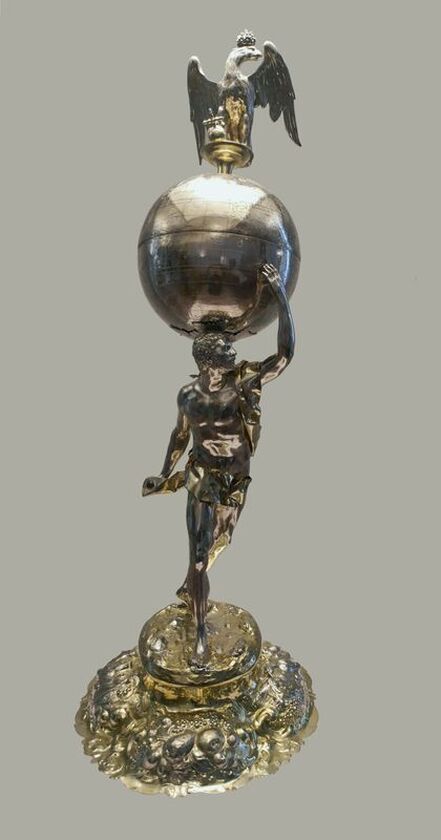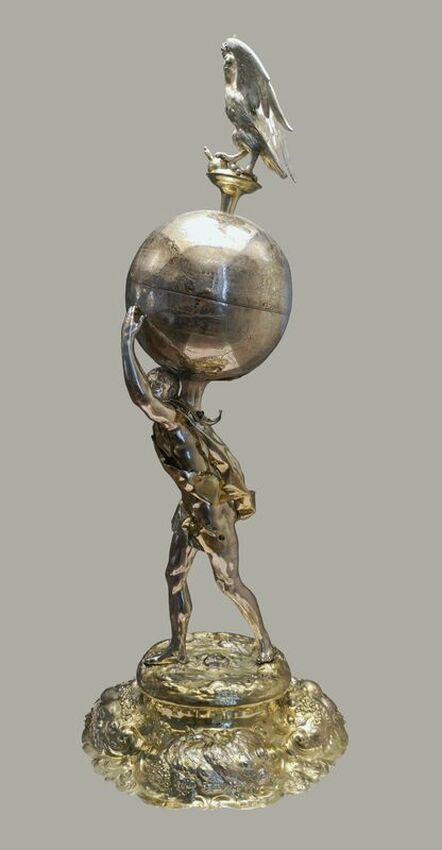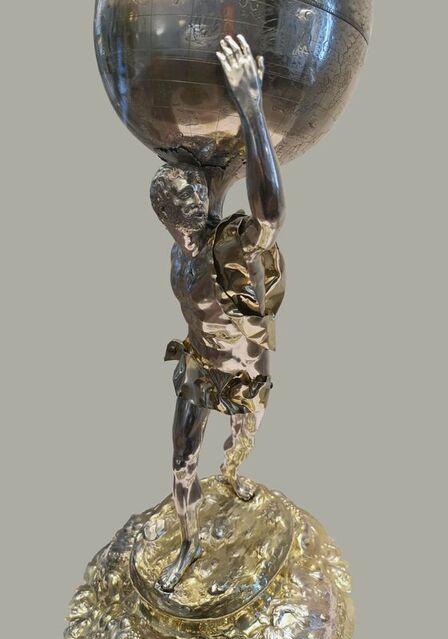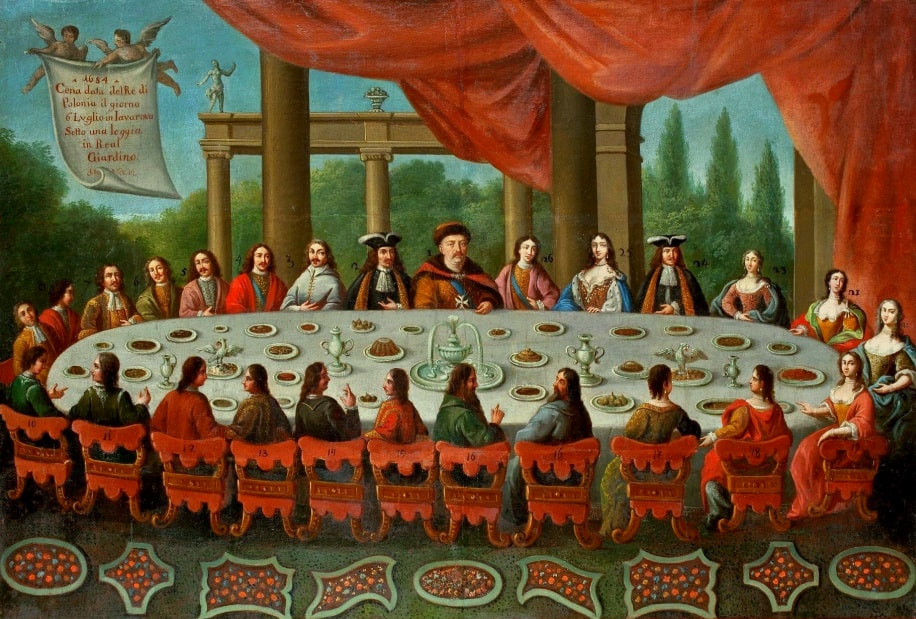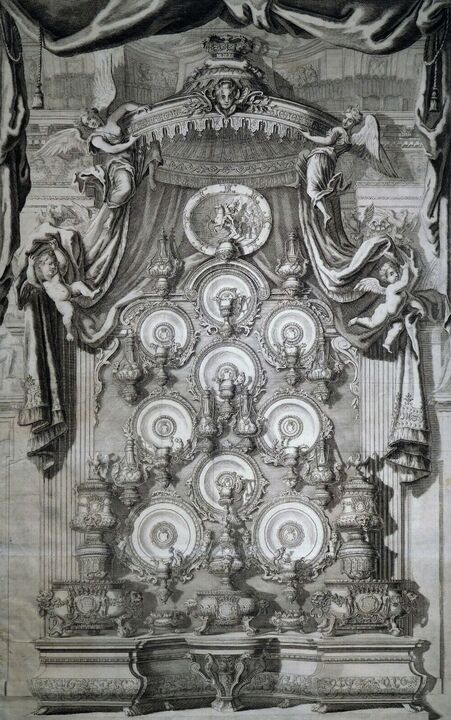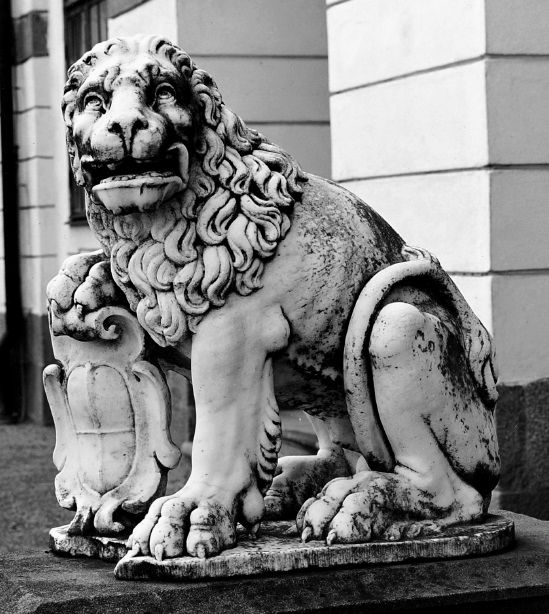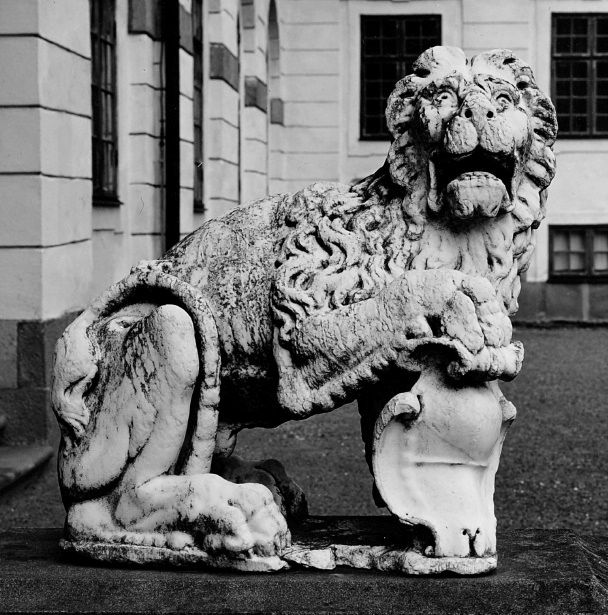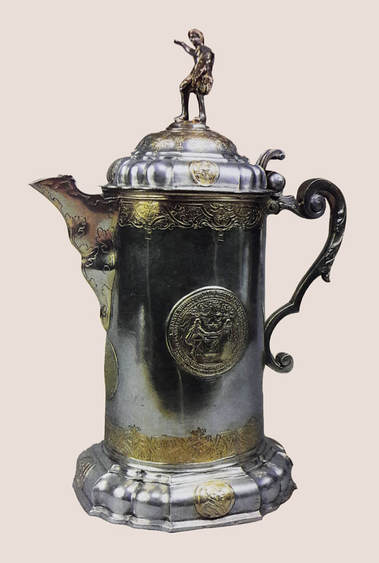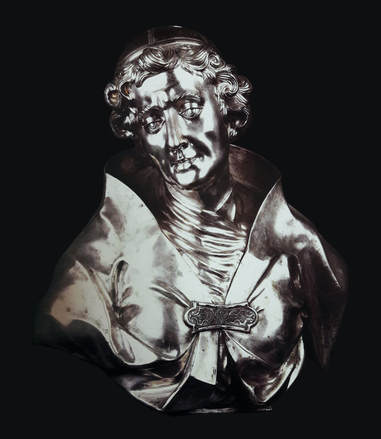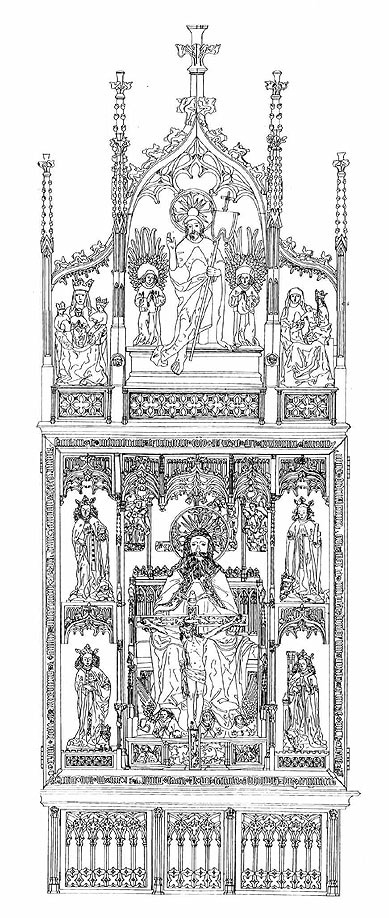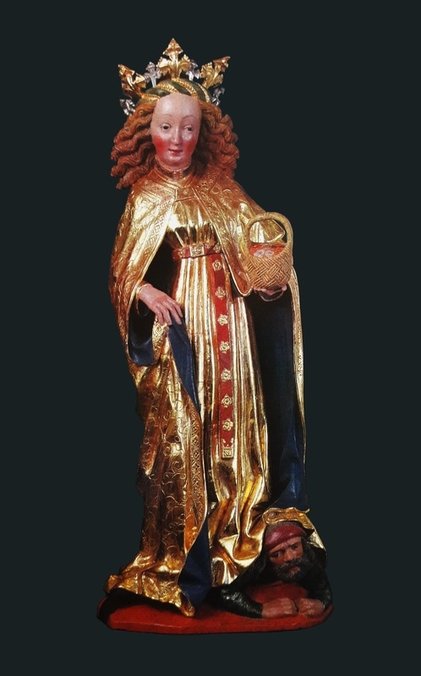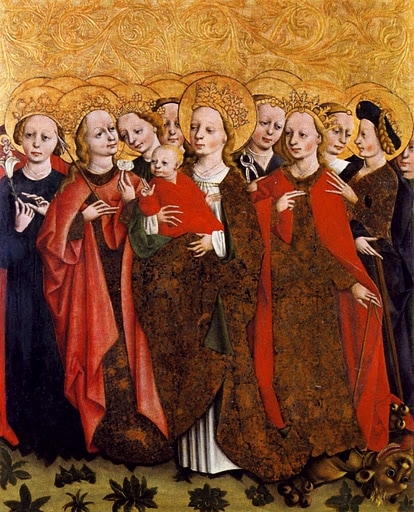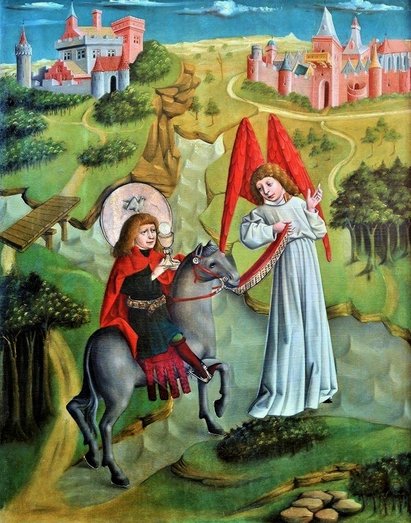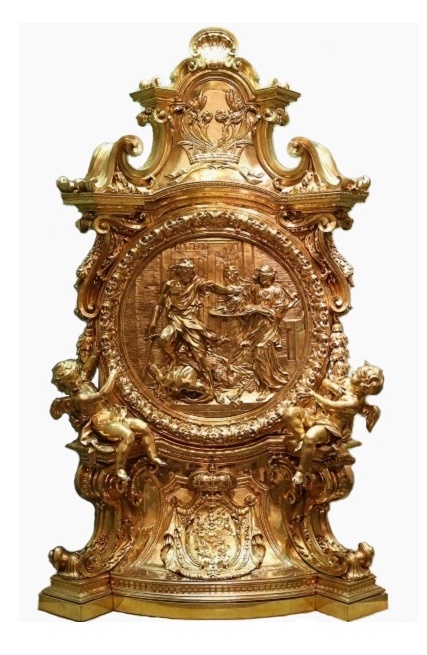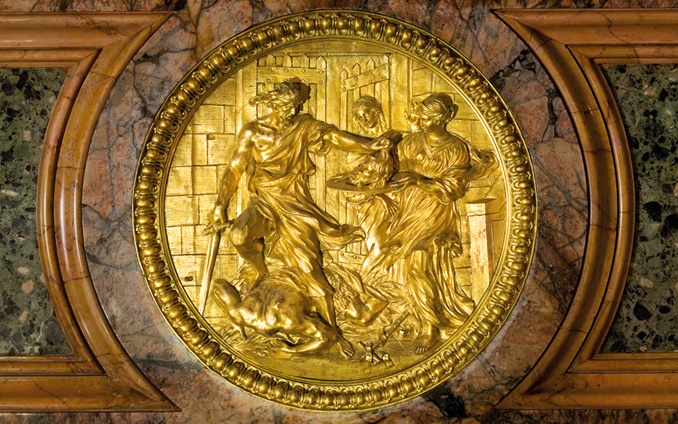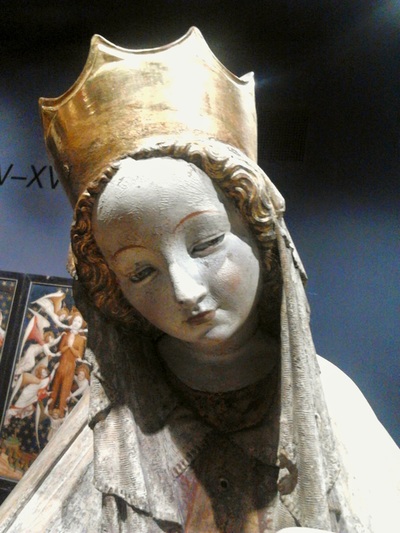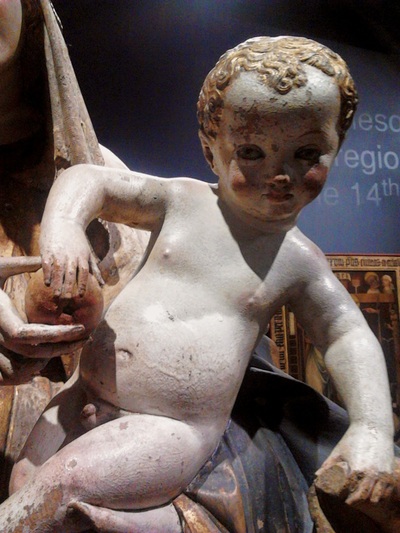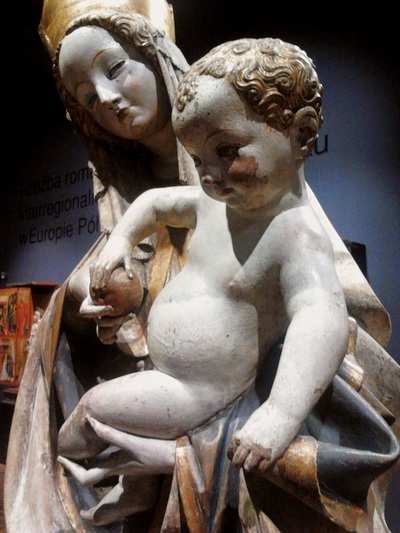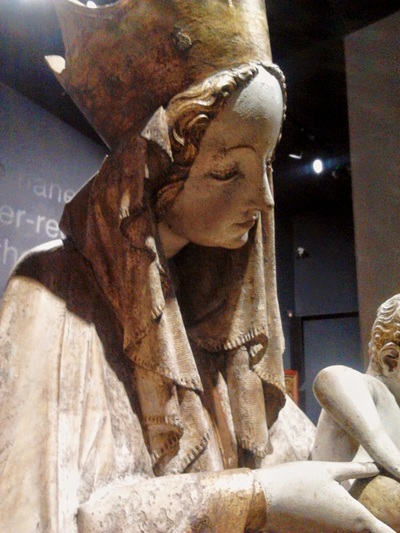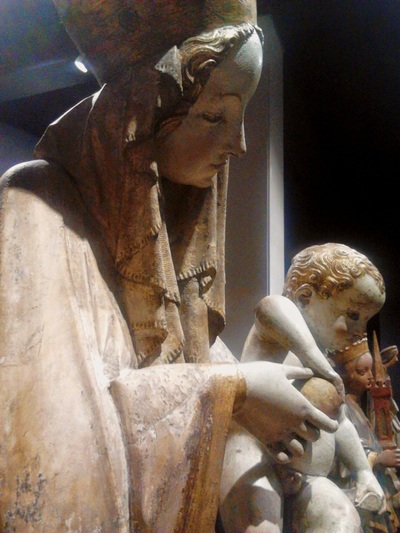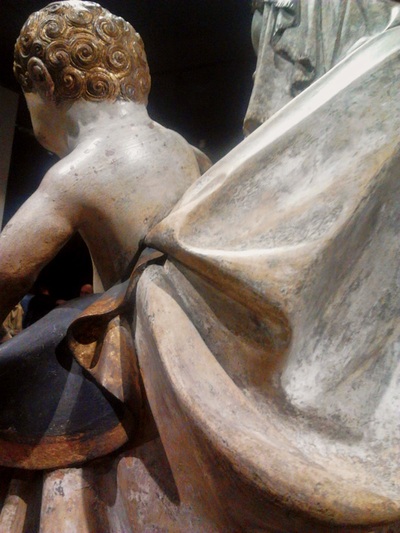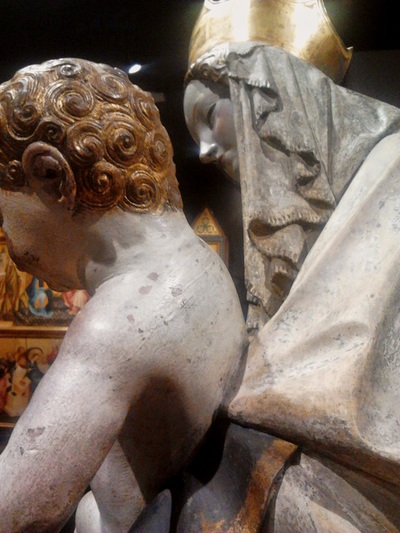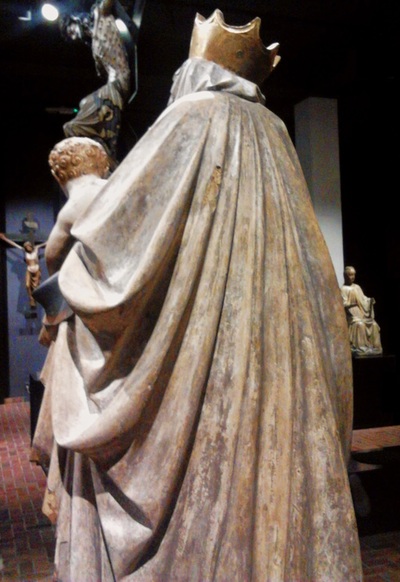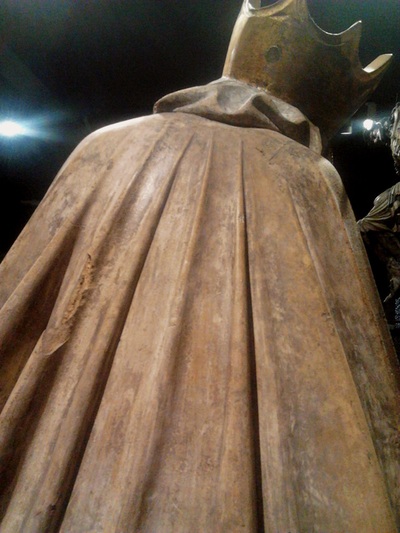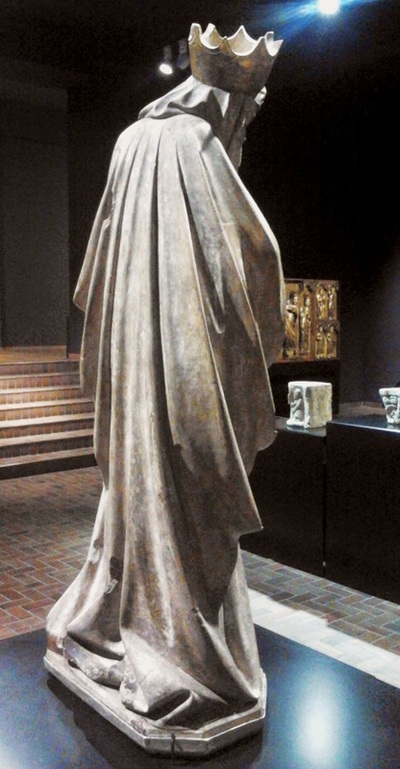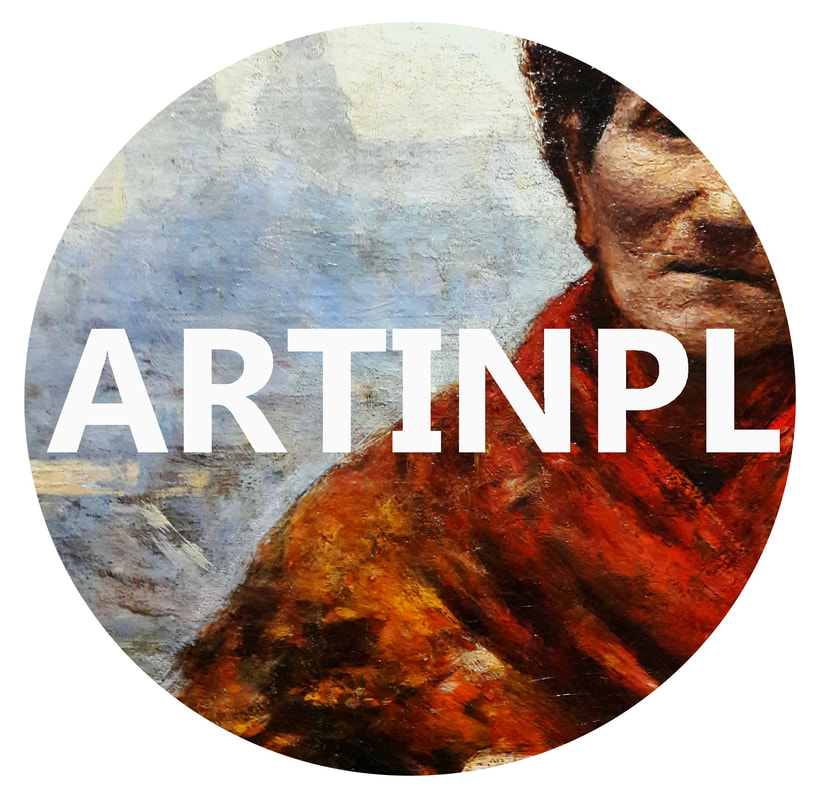|
In 1530, the nine-year-old Sigismund Augustus, son of Sigismund I the Old and his second wife Bona Sforza was crowned as co-ruler of Poland-Lithuania alongside his father. That same year he was also engaged with his four-year-old cousin Elizabeth of Austria, daughter of Anna Jagellonica, Queen of Germany, Bohemia, and Hungary. On 5 May 1543 then 16-year-old Elizabeth married 22-year-old Sigismund Augustus. The king, who already had several mistresses, did not find Elizabeth attractive and continued to have extramarital affairs.
In the course of the year 1545, on June 15th, the young queen Elizabeth died of an epileptic seizure in Vilnius. Her body filled with lime was awaiting the king's arrival from Kraków on July 24, over one month after her death. On August 25, 1545 the body of Elizabeth was buried in Saint Casimir Chapel of the Vilnius Cathedral. After half a year, on January 9, 1546, in Kraków, Seweryn Boner, the commissioner of Sigismund Augustus, signed a contract with the sculptor Giovanni Maria Mosca called Padovano, to create a tombstone for Elizabeth. Padovano, born in Padua and summoned to Sigismund I's court in 1529, became the main sculptor in Kraków after the tragic death of Bartolommeo Berrecci, murdered in 1537 by another jealous Italian artist. He created several tombstones for Vilnius Cathedral, including most probably tombstone for Vytautas the Great, commissioned by Bona Sforza. As early as 1546 Padovano undertook, together with Giovanni Cini, to create the tombstone for Elizabeth. Sometime in 1547, in spite of his mother's disapproval, Sigismund Augustus secretly wed his mistress Barbara Radziwill, she died however on 8 May 1551 in Kraków, five months after long battled coronation, of syphilis, cancer or poisoned by Bona. Barbara asked to be buried in Vilnius and her body was transported to Vilnius Cathedral, where she was buried on 23 June next to Sigismund Augustus' first wife. One of her state portraits (a copy in the Royal Castle in Warsaw, inventory R-ZKW-161), which was probaly used as model for the tomb monument, reflects her great love for precious stones and pearls. She was depicted in a traditional wimple of a married woman covered with pearls and gold-diamond brooches, gold-diamond pendant on a gold chain with a large pearl, comparable with famous La Peregrina or the Tudor pearl, and another gold chain with a precious stone cameo with a bust of her husband, most probably created by Jacopo Caraglio, court goldsmith and medallist of Sigismund Augustus. In January 1552, Jan Lutomierski, royal court treasurer, ordered 8 blocks of red "marble" (Adnet limestone) in Salzburg from Rupert Beyr (pro sepulchro Ser. olim Dominae D. Reginae Barbarae marmores octo iuxta ...), together with one block for the monument of Bishop Samuel Maciejowski in the Wawel Cathedral. The marble was transported to Kraków, from where, after preliminary processing, the blocks were floated down the Vistula to Gdańsk and Königsberg, then up the Nemunas and Neris rivers to the capital of the Grand Duchy of Lithuania covering a total of over 1,500 km. On June 24, 1552 the tomb monument of Queen Elizabeth, created in Kraków, was brought to Vilnius and put in storage in the Franciscan monastery, and on April 18, 1553, Lutomierski signed a contract with Padovano with an advance payment of 280 florins for execution of the monument to Queen Barbara (convenit cum Joanne Maria, Italo lapicida, de labore sepulchri Ser. olim D.D. Barbarae ...). The main sculptural work Padovano performed together with Giovanni Cini on site, in Vilnius. The final bill of 971 florins and 13 groszy for the monuments to both queens was issued in 1562 (In sepulchrum et marmores Serenissimarum Elizabethae et Barbarae Reginarum). Similar to Maciejowski's monument, created by Padovano in 1552, the royal tombs in the form of arcosolium (an arched recess), undoubtedly portrayed the deceased queens' in the fashionable "Sansovino pose", referring to the statues of Roman courtesans of the Flavian era, sleeping above the sarcophagus and turned towards the viewer. It was a revival of the Etruscan models, as opposed to the traditional medieval model which saw the deceased lying in a more rigid way and celebrating a dead person, in favor of a new conception exalting the living person. The works inspired later realisations, like monument to Barbara Tarnowska in Tarnów from the 1550s, monument to Elżbieta Zebrzydowska in Kielce, created by Padovano after 1553, monument to Urszula Leżeńska by Jan Michałowicz of Urzędów in Brzeziny, created between 1563-1568 or monument to Barbara Górka by Girolamo Canavesi in Poznań, executed after 1574. In the last years of his reign Sigismund Augustus decided to built in the Vilnius Lower Castle, on the site of the former medieval chapel of St. Anne, destroyed by a fire in 1530, the new church of St. Anne and St. Barbara as a mausoleum for his wives. The coffins of the two queens were to be stored in Vilnius Cathedral, only until the construction of the church would be accomplished, which the monarch expressed in his last will: The testament of His Majesty Sigismund Augustus, who died in Knyszyn on July VIIth of the year from the Nativity of Our Lord MDLXXII (Library of the Kórnik Castle, copy of the Puławy manuscript by Kielisiński) [...] The bodies of deceased Ladies our Spouses, dead in Our Lord, we want them to be from the Chapel of St. Casimir, where they are put in depository, in this church of St. Anne to be transferred and buried there. The body Her Majesty Halska [Elizabeth] on the right side of the Church by the altar on the side of choir in the corner of the Church. And the Queen Her Majesty Barbara also from this side of the choir in the corner of the Church on the left side. [...] For all this benevolence to Her Majesties our Sisters, often mentioned, the Church of St. Anne, aforementioned and begun by us [...] and as it is acceptable according to custom, if we will be buried there, to built a grave on the aforementioned site worthy our state. Also to Queen Her Majesty Halska [Elizabeth] to erect a grave, which is ready at Jop's. Also to Queen Her Majesty Barbara, after moving their bodies, to erect a grave on the above-described places. Sigismund II Augustus died childless on 7 July 1572 in Knyszyn. The Union of Lublin signed on 1 July 1569 created a single state, the Polish-Lithuanian Commonwealth, a republic of nobles with elective monarchy. On 15 December 1575 Sigismund Augustus' sister Anna Jagiellon was elected as co-ruler of the Commonwealth, together with her husband Stephen Báthory. The king's sisters were reluctant to fullfill his last will concerning the burial of his wives. It is probably due to Bona Sforza's animosity with both wives of her son, that Anna, who was very active in religious foundations (in 1578 she established at Warsaw's Bernardine Church of Saint Anne the St. Anne's Brotherhood), and supervised the construction of tomb monuments for herself, her brother, husband and mother, also not accomplished the delivery of this deed. Anna Jagiellon promote her niece Anna Vasa or her nephew Sigismund Vasa, children of her beloved sister Catherine, Queen of Sweden as candidates the the Commonwealth's throne after her death. Sigismund was elected the monarch of the Commonwealth in 1587 and in 1592 he succeeded his father as the King of Sweden, hence creating one of the largest federal states of the 16th century Europe, but was deposed in Sweden by his uncle Charles IX in 1599. In July 1655, the grandson of Charles IX, "the Brigand od Europe", as he was called by Stefan Czarniecki, Charles X Gustav of Sweden willing to enlarge the Swedish Empire and taking advantage of the Russian invasion, advanced on the Polish-Lithuanian Commonwealth, thus triggering one of the most devastaing wars in the history of the Central Europe, the so-called Deluge (1655-1660). The Commonwealth was attacked from north, south, east and west. On 8 August 1655 Russian and Cossack forces captured Vilnius. The city was pillaged, burned and the population was massacred. According to the Russian historian Flavian Nikolayevich Dobryansky (1848-1919) "everything that was holy and beautiful inside and outside the city was burned; the rest was destroyed, not only the roofs, but also the tombs" (Old and New Vilna. Third edition of 1904). Just as marble tombstone of Paul Olshanski, Bishop of Vilnius in the Vilnius Cathedral, created by Padovano in 1555, and monument to Lew Sapieha, Great Lithuanian Hetman and his two wives in the Church of St. Michael in Vilnius from the 1620s, wich were damaged during that time, the royal effigies were most probaly also devastated. The unfinished and dilapidated church of St. Anne and St. Barbara was left empty until 1666, when, at the request of the prelate Mikołaj Słupski, the king John II Casimir Vasa, great grandson of Bona Sforza, allowed the architect Jan Salwador to dismantle the building and use the materials and funds obtained from it to repair another badly damaged building, the Vilnius Cathedral. The precious marbles from the royal monuments were probably also reused. Marble tondo of 46.5 cm in diameter from the collection of the Vilnius Univeristy, depicting a woman with long hair in antique costume, which was before the World War I in the Rumyantsev Museum in Moscow, was supposed to come from Elizabeth of Austria's tombstone.
Fragment of marble tomb monument of Elizabeth of Austria (1526-1545), Queen of Poland and Grand Duchess of Lithuania, first wife of Sigismund II Augustus by Giovanni Maria Mosca called Padovano and Giovanni Cini in Kraków, 1546-1552. Hypothetical reconstruction by Marcin Latka ©. All rights reserved.
Fragment of marble tomb monument of Barbara Radziwill (1520/23-1551), Queen of Poland and Grand Duchess of Lithuania, second wife of Sigismund II Augustus by Giovanni Maria Mosca called Padovano and Giovanni Cini in Vilnius, 1553-1562. Hypothetical reconstruction by Marcin Latka ©. All rights reserved.
See more pictures of Last Polish Jagiellons on Pinterest - Artinpl and Artinplhub
The palace was built between 1639-1642 by Lorenzo de Sent for the Grand Crown Chancellor Jerzy Ossoliński in Mannerist style. It was constructed on the plan of an elongated rectangle with two hexagonal towers at garden side of the building. The palace was crowned with a terrace with a balustrade, above which stood the upper part of the great representative hall, covered with a spherical roof. A possible inspiration for the palace's upper pavilion and its characteristic roof was Bonifaz Wohlmut's reconstruction of Queen Anne's Summer Palace in Prague, 1557-1563.
Adam Jarzębski, styling himself as Musician of His Highness Ladislaus IV and manager of the construction of the royal palace at Ujazdów, in his "Short Description of Warsaw" (The Main Road, or a Short Description of Warsaw) from 1643, described the residence of Jerzy Ossoliński: Facade with statues of four kings, below inscriptions and a brass statue of Poland holding a sickle, with a plow and a sheaf and marble portal (2427-2435), in the middle of a building a hall covered with roof tiles with gilded brass statues in the corners (2445-2450), Elongated outbuilding with servant lodgings and a kitchen (2711-2713), stables building opposit with a gate (2720-2725), Vestibule with marble portals and iron doors of master craftsmanship (2505-2508), and a staircase with a grille and a large, solid lock (2520-2525), Large dining room (2465) with niches with statues of white marble and a brass statue of a Cupid holding a bow above the door, chandelier and tapestries (2475-2485), with a door to a wine cellar (2491) and a room with silver and gold tableware (2495-2496), Hall with upper windows and a fireplace of black highly polished marble with equestrian portrait of king Ladislaus IV Vasa on white horse against a battle scene (2527-2538), a row of family portraits by painter Hans (?) Amman, and paintings reproducing the epic tales of the ancestors, including a story of a knight wounded during a jousting tournament who was healed by Saint Anne, other stories and battle scenes, above busts of Roman Emperors of white marble (2553-2570), stucco trees in corners, most probably by Giovanni Battista Falconi, ceiling decorated with figures, animals and floral motifs and a painting depicting coronation of Queen Cecilia Renata of Austria in presence of chancellor Ossoliński, door portals of black marble with portiere tapestries with Topór (the Axe) coat of arms (2575-2600), polished marble floor (2605-2607), Lord's chambers with tapestries, French-style parade bed, tables with gold trinkets and silverware and decorative clocks beside the bed, coffers, fireplace adorned with a mosaic (2611-2632), Cabinet of curiosities in a right side tower with bronze statues of different horses, birds and people (2635-2644), silver plated cupboard-cabinet with gold inscriptions describing the contents of each drawer (2649-2652), marble table with rarities on it (2659-2662), Chapel in the left side tower with an altar with an exquisite painting, relics in glass vessels, offered by the Pope, silver coffer reliquary with bones bound by gold chains, wax miniatures, a table with a casket and a door to a staircase (2667-2692). In 1633 Ossoliński was sent with a diplomatic mission to the Pope in Rome by newly elected monarch of the Polish-Lithuanian Commonwealth, Ladislaus IV Vasa. The King offered him the starostwo of Bydgoszcz, 60,000 zlotys, six horses, a saber (scimitar) worth 10,000 zlotys, five Brussels' tapestries making up the series of the Story of Moses commissioned by King Sigismund Augustus in the 1550s, three of which were given to the Pope, and a construction site in Warsaw. An event from 1633 is also worth mentioning when Ossoliński, traveling to Rome via Veneto, fascinated by the beauty of one of the villas near Padua, ordered to immediately take its dimensions. He made his entry to Eternal City wearing a żupan, richly embroidered with gold, buttoned up with 20 large buttons with diamonds, gold sabre set with jewels valued at 20,000 Polish zlotys and mounting a Turkish stallion having golden horseshoes and a horse tack set with precious stones. In 1638 a life-size statue was cast in brass by Gerdt Benning in Gdańsk according to the design by Georg Münch for then the vice-chancellor Jerzy Ossoliński, most probably to his Castle in Ossolin. It is possible that the same workshop created statues to his Warsaw's palace. Contrary to the Crown Court Marshall Adam Kazanowski, who had a transgender man at his court, the Chancellor Ossoliński kept a transgender woman in his palace: "a boy who thinks he is a girl, and who also wears a dress: He imitates a girl quite well; especially in that, he is very eager of being cuddled", as recounted Jean Le Laboureur in his "Account of the voyage of the Queen of Poland", published in Paris in 1647 (p. 212). An engraved effigy of the Chancellor by Willem Hondius from 1648 was created after a portrait by Bartholomäus Strobel. It is possible then that Strobel created more painting for Ossoliński, including for his Warsaw's residence. In 1645 the chancellor commissioned the silver-ebony altar for the Chapel of Black Madonna of Częstochowa adorned with his coat of arms. The design was most probably by a Royal court artist Giovanni Battista Gisleni, while silver elements were created by the Royal goldsmith Johann Christian Bierpfaff in Warsaw in 1650. The "Inventory of belongings spared from Swedes and escapes made on December 1, 1661 in Wiśnicz" in the Central Archives of Historical Records in Warsaw, lists some of the preserved paintings from Chancellor's rich collection inherited by his daughter Helena Tekla Ossolińska, wife of Aleksander Michał Lubomirski, owner of the Wiśnicz Castle. 30 paintings from Chancellor's collection in the inventory include the paintings by Raphael, Titian, Guido Reni, Guercino, Domenichino, Veronese, Ribera, Albrecht Dürer and Daniel Seghers. There were also there a painting of the Leda and a swan, a gift from the Emperor, a Cupid sharpening his bow, possibly a copy of the famous work by Parmigianino, acquired in Rome, a "large Blessed Virgin Mary, a wreath around her made of fruits, which the angels holds", most probably by duo of Rubens and Jan Brueghel, and a large canvas showing Chancellor's Entry into Rome in 1633. Ossoliński died in his palace in Warsaw on August 9, 1650, at the age of 55. He was buried in the church of St. Joseph in Klimontów, which he built. His opulent palace in Warsaw was destroyed during the invasion of the Commonwealth by neighbouring countries, known as the Deluge (1655-1660).
Adam Jarzębski, styling himself as Musician of His Highness Ladislaus IV and manager of the construction of the royal palace at Ujazdów, in his "Short Description of Warsaw" (The Main Road, or a Short Description of Warsaw) from 1643, dedicated to his benefactor Crown Court Marshall Adam Kazanowski, thoroughly described the residence of this baroque celebrity.
Kazanowski gained prominence as a close friend and companion of crown prince Ladislaus Sigismund Vasa, who was elected monarch of the Polish-Lithuanian Commonwealth from 1632 as Ladislaus IV. Together with his brother, Stanisław Kazanowski, Adam was raised with crown prince and accompanied him during his attempt to become a Russian Tsar, in the Khotyn war of 1621 and the 1624 to 1625 European voyage. A breakthrough event for Adam was when his elder brother Stanisław, favourite of crown prince, attacked with syphilis was expelled from the court for promiscuity in 1620. Zygmunt Kazanowski, father of both, had great hopes for the relationship of his older son and young Vasa. Faced with the threat of his imminent death, he persuaded the sick to recommend his younger brother to the prince. Both brothers were accused by Jerzy Ossoliński in his Memoirs of organizing "suspicious" amusements for young prince. When the crown prince became king, Adam was showered with gifts and new official titles. In 1628, at the age of about 29, Kazanowski decided to get married. He chose Elżbieta Słuszczanka, a daughter of wealthy Castellan of Minsk, Aleksander Słuszko, for the future bride. The marriage meant for him not only a substantial dowry, but also valuable connections in the Grand Duchy of Lithuania. Aleksander Słuszko dismissed the suitor, justifying the refusal with his daughter's young age, as Elżbieta was then only 9 years old. However, thanks to the intervention of the crown prince, Aleksander Słuszko changed his mind. The wedding took place in the spring of 1633, when Elżbieta has reached the legal age of 14. Adam, who also became the Grand Pantler of the Crown that year, gained 50,000 zlotys of dowry. In addition, the young couple received 20,000 zlotys from the king and the value of the gifts was estimated at 40,000 zlotys. When crown prince Ladislaus Sigismund became an adolescent, his father Sigismund III Vasa bought him a wooden mansion of Andrzej Bobola at the Cracow Suburb Street in Warsaw. In 1628, shortly after his return from a journey to Western Europe, the prince ordered Constantino Tencalla a court architect to build him a new palace in the Italian style. Four yers later, in 1632, Ladislaus gave the palace to Kazanowski, which caused serious misunderstanding with his father, and a special Parliament committee was appointed to determine the circumstances behind this gesture. In 1637, Kazanowski enlarged the building, holding to Tencalla's original designs. The new structure was a large four-storied palace with a garden, enormous terrace, central courtyard, copper roofs and tower tops decorated with gilded crowns. 629 verses (1025-1654) of Jarzębski's work portray the lavish mannerist and early baroque palace constructed between 1628 and 1643 in the center of informal capital of the Commonwealth: Large arsenal filled with cannons, muskets, excellent armors, tents and turkish garments, lances and spears arranged on the walls, field guns, matchlocks and a skin of a lioness (1057-1066), Long gallery filled with paintings on both sides with nudes above the table, portraits of the King Ladislaus IV Vasa and his wife Cecilia Renata of Austria, painted Ad vivium and noble ladies, stone statue of Atlas supporting the armillary sphere on the table in the middle (1095-1108), Small arbor room adjacent to gallery with a French window, columns, stone floor and a view of the river Vistula (1121-1127), Dining room with windows on two storeys, a large chandelier with a clock showing hours, a balcony for musicians and Flemish tapestries woven with golden thread (1131-1153), chairs covered with gilded cordovan, plaques with coat of arms of the Lords and Marshals between windows in upper part and landscape paintings and cordovan in lower part, tile stove (1177-1187), window with a wine lift from basement, a large silver wine vessel of 150 litres on wheels in the shape of Bacchus wearing a wreath, sitting on a barrel and holding a goblet, several other barrels half the size of the main and a silver wine fountain in the middle of the room, silver ewers, pitchers and trays (1188-1214), the King and the Queen, envoys from Muscovy, the emperor, the king of Spain, Turkey, France and Persia were received there (1162-1171), Vaulted steam baths near the coach house with two chambers, hot stone, heating house, cold and hot water, copper bathtubs and white benches (1255-1272), Room on upper floor covered with cordovan, with a fireplace, marble portals with gold inscriptions, statues in overdoor (1305-1318) and muskets on the walls (1323), Rooms with paintings and tapestries: animalistic paintings and still-lifes with vegetables by master painters in the first, next room with staircase, seascapes and paintings of ships, casket regals, a harpsichord, a lute, a violin, cymbals, a viol and a harp and doors hung with portieres (1325-1343), next room with live animals, monkey on a chain, white parrot, singing birds in cages, still life paintings with fruits and wines, tapestries, a fireplace and a marble table (1349-1364), Lord's bedroom with a table, a painting of Adam and Eve, a bed against tapestries, good paintings, a fireplace and marble floor, a folding bench with wheels (1381-1392), trellis giving to the chapel, altar with gilded grille and a window to the ladies' room (1365-1376), Lord's study with a mirror, angels' statues holding candles, paintings, tapestries and polished marble floor (1407-1418), Library with foreign books in different languages, khanjar daggers on the table, daggers set with turquoises, gold bowls and rock crystal vessels (1425-1431), Lady's rooms, in one of them tortoiseshell caskets, pendant paintings, one with an old man with a sore eye, tapestries and looms (1437-1449), bedroom covered with goldcloth, a draped bed made of a rich fabric, mirror in silver frame above the table, the other in gold plated frame, automaton clock with a man, paintings in ebony frames, marble floor and marble table (1457-1469), a bedroom with a bed of green goldcloth with fringe and a portrait of mother of Her Majesty, Zofia Konstancja Zenowicz, in the next room in the corner of the palace a portrait of father of Her Majesty, Aleksander Słuszka, in his old age above the door, in both rooms marble fireplaces, tables covered with kilims and marble floors (1473-1495), Treasury on the groundfloor, the first room filled with guns: bird shotguns, Turkish trench guns, carabins, muskets and Italian pistols, laid with gold and silver, tables covered with Persian kilims (1508-1520), treasury room with gilded stuff set with turquoises, eastern backswords, gold sabres, gold and gilded saddles and horse tacks, sable coats, large trays and ewers in boxes and antique treasures, snake skin and a turtle from India (1530-1561), Belvedere room with grille with a view of a garden (1579-1582), wine basement with barrels of wine, mild, sweet and spicy (1590-1596), and a beer basement (1601), in the room above a workshop of Dutch painters (1603-1608), next a room with silverware (1612), and a room with hunting falcons (1613), marble pantry with venison, partridges (1641-1645) and a room of captive Muslim Tatar servants (1649-1651). Three years later, in 1646, Jean Le Laboureur, a companion of the French Ambassador Extraordinaire to Poland, Renée du Bec-Crespin, comtesse de Guébriant, visited the palace and described it in his "Account of the voyage of the Queen of Poland", published in Paris in 1647. He devoted five pages of his book to the building: Five or six large chambers and several smaller rooms, filled with silk and gold oriental fabrics, beds of gold fabric, cabinets of uncommon workmanship, tables with different items of gold, silver, amber and stones (p. 211). Large room with marble floor, as the rest of the lodgings, with a large wine fountain, made of silver in the middle, large platform above the door for the musicians, table with 80 silver-gilt Italian style tazzas (four rows of twenty each) with dried fruit, large pears in sugar, oranges, lemons, melons (p. 213), buffet with extraordinary gold and silver vessels, including Bacchus "of a natural height" sitting on a silver barrel with gold wheels, rock crystal glasses with silver-gilt mountings, Elżbieta Słuszczanka was dancing here with her brother Bogusław Jerzy Słuszka, Court Treasurer of Lithuania and marquis Gonzaga Myszkowski with his wife (p. 214). Kazanowski, struck by the sudden invasion of gout, welcomed the guests at the staircase of his palace carried in a litter (p. 210), accompanied by 300 armed guards, more than 50 pages dressed in yellow satin and short jackets of blue satin, his wife and her ladies (p. 211). In one of the chambers Le Laboureur noted "two extraordinarily small female dwarfs who were standing up like a sentry, to guard two small dogs, who were not less dwarf in their species, for they are the size of a mice, and both were resting in a white basket little larger than the hand, on a pillow of perfumed satin", while the ladies of Elżbieta Słuszczanka had a transgender man, a woman who behaved like a man, "for their entertainment" (p. 212). In 1643 Kazanowski also arranged a marriage of dwarfs, "an unheard wedding, full of laughter", according to Albrycht Stanisław Radziwiłł. Following her visit, Kazanowski and his wife, sent to Madame de Guébriant some small amber cabinets and clocks set with diamonds (p. 212). Little is known about artistic patronage of the Crown Court Marshall. Among confirmed artists at his court was certain Ezechiel Sykora, born in Litomysl in Czechia in 1622, who latinized his family name to Paritius. After Kazanowski's death in 1649 he left Warsaw and went to Silesia. As a żupnik (manager) of the Royal Salt Mines, he commissioned from Gdańsk engraver Willem Hondius in 1645 a series of views of the Wieliczka salt mine. Kazanowski had also a book of friendship (album amicorum/Stammbuch), wich was in collection of Edward Rastawiecki in Warsaw in 1853. Small oblong book bind in crimson velvet had 125 parchment leaves and majority of contributions from the years of between 1624 and 1625 of his European journey and a few from 1627 to 1644, mainly of ambassadors of the Spanish Empire. During his stay in Brussels in 1624 with the crown prince he received from infanta Isabella Clara Eugenia a gold medallion set with precious stones on a gold chain. It is possible that he intentionally tried to emulate great validos of his time, Duke of Lerma or Count-Duke of Olivares. Kazanowski died childless in 1649, leaving all his property to his wife Elżbieta. His opulent palace in Warsaw was destroyed during the invasion of the Commonwealth by neighbouring countries, known as the Deluge (1655-1660).
On June 17th, 1696 died in the Wilanów Palace in Warsaw after 20 years reign, John III Sobieski, elected monarch of the Polish-Lithuanian Commonwealth. Shortly after king’s death an inventory of his belongings in the palace was opened. The document contains 122 positions of exquisite silverware, some of which could be created for 20th anniversary of king’s coronation on February 20th, 1696. In the part of royal treasury supervised by burgrave Brochocki, there was "a silver pyramid with 11 baskets made in Augsburg (No. 9.)", "a silver bowl made in Augsburg with a cover with phoenix (No. 4.)", "a three storey fountain with gilded elements made in Augsburg (No. 8.)" and "partially gilded service made in Augsburg with salt cellars, trays, vinegar cruets, bowls and Hercules in the center (No. 7.)". According to inventory the latter service had total weight of 56 grzywnas and 12 łuty, while the Kraków grzywna, used in Poland after 1650 weighed 201.86 g, therefore total weight of the service was approximately 11,304.16 g. Similar vessel from the Green Vault in Dresden (inventory number IV 292), created in 1617 in Nuremberg by Heinrich Mack and Johann Hauer, meaure 75 cm with 4686 g weight.
The inventory also lists some gifts from foreign monarchs including gold bowl offered by Elector of Brandenburg (till 1657 a fief of the Commonwealth as Duke of Prussia) - “gold bowl in the shape of a shell presented by Elector of Brandenburg with his coat of arms” 894 red zlotys worth, inherited by prince Aleksander Benedykt Sobieski. On March 24th, 1712 arrived to Berlin, a capital of newly created Kingdom of Prussia (earlier Brandenburg), an envoy of the Polish-Lithuanian Commonwealth and Saxony, count Jacob Heinrich von Flemming. His mission was to negotiate alliance against Sweden (diplomatic credentials for Flemming, Dresden March 17, 1712 [O. S. A. Rep. XI: 247 ii Fe. 55]). Both Prussia and Sweden, growing military powers in the region, pose a significant threat to the Commonwealth. Prussia claimed Courland, a vassal Duchy of the Commonwealth, Varmia and Elbląg, while Swedes were even more perilous for elected successor of John III Sobieski, Augustus II the Saxon, called the Strong, as they supported Stanislaus Leszczyński, a candidate to Commonwealth’s crown and Augustus’ rival. The king was prepared to make far-going territorial concessions to alleviate Prussia and the envoy undoubtedly has not arrived barehanded. It is possible then that Augustus has sent from Warsaw a part or whole silver service made for Sobieski, as a gift. Table centerpiece with Hercules carrying the terrestrial globe and royal eagle in the Köpenick Palace, a branch of Museum of Decorative Arts in Berlin (inventory number S 559), is probably the largest and the only preserved part of the mentioned service. It measures 80 cm and bears hallmark of the city of Augsburg as well as master mark LB with a star. Stylistically the work should be attributed to Lorenz II Biller (active between 1678-1726) and dated to 1680s. The work was signed in the center of the celestial globe in Latin: Christoph Schmidt fecit Augustae 1696. Schmidt most probably modified the work by Biller’s workshop, acquired by some important patron that year, John III Sobieski. The statue also bears the date: 17 M 12 [March 1712?] at the bottom of the base on the right, possibly an inventory date. Later the centerpiece was included in the so-called great silver buffet in the Berlin City Castle. Two similar vessels are visible in the drawing from the end of the 18th century, depicting the composition of the silver buffet in about 1763 and are not visible in original composition of the buffet by Johann Friedrich Eosander from 1708. The centerpiece was therefore included in the composition between 1708 and 1763, which makes Polish provenience even more accurate.
Table centerpiece with Hercules carrying the terrestrial globe and royal eagle by Lorenz Biller II and Christoph Schmidt in Augsburg, ca. 1685 and 1696, Museum of Decorative Arts in Berlin.
Fragment of table centerpiece with Hercules carrying the terrestrial globe and royal eagle by Lorenz Biller II and Christoph Schmidt in Augsburg, ca. 1685 and 1696, Museum of Decorative Arts in Berlin.
Banquet given by John III Sobieski to foreign diplomats and Polish dignitaries at Jaworów on 6 July 1684 by Frans Geffels, ca. 1685, National Museum in Wrocław.
Silver buffet in the Berlin City Castle by Martin Engelbrecht, circa 1708, engraving published in Theatrum Europaeum, Volume XVI, 1717, private collection.
See the work in Polish-Lithuanian Treasures.
Two marble lions at the main gate of the Drottningholm Palace in Sweden, credited by some sources as possibly taken by the Swedish forces from the Frederiksborg Castle in Denmark, could be rather, beyond any doubt, identifed with four marble lions described by Adam Jarzębski in his "Short Description of Warsaw" from 1643, as adorning the entrance to the Ujazdów Castle in Warsaw - I lwy cztery generalne, Między nimi, naturalne, Właśnie żywe wyrobione, A z marmuru są zrobione; Nie odlewane to rzeczy, Mistrzowską robotą grzeczy (2273-2278).
In the 1630s, before his wedding with Cecilia Renata of Austria, Ladislaus IV Vasa made several commissions for sculptures in Florence, including possibly lions for his palace in Ujazdów. Both material, Italian marble, and a form similar to Medici lions, makes this assumption more probable. Also quarterly divided fields of lions' escutcheons with wiped away crests, suggest an eagle and a knight of Poland-Lithuania, rather than more complex emblems of Christian IV of Denmark.
Marble lion from the Ujazdów Castle by Anonymous from Italy, 1630s, Drottningholm Palace. Photo: Nationalmuseum (CC BY-SA).
Marble lion from the Ujazdów Castle by Anonymous from Italy, 1630s, Drottningholm Palace. Photo: Nationalmuseum (CC BY-SA).
After two centries of domination as the main center of craftmanship of the Polish-Lithuanian Commonwath, the country's main port, Gdańsk, began to decline in the beginning of the 18th century. The transfer of royal court from Dresden, into Warsaw during the Seven Years' War in 1756, ended another half-century hegemony of the Saxon capital. Royal court in the capital of the Kingdom of Poland favored greatly developmnent of local workshops. Also many skilled gold- and silversmiths from other locations began to settle in Warsaw. Among the most notable were Antoni Ignacy Mietelski (d. 1737), originally from Warka, who settled in Warsaw in 1717. In 1725, 1733 and 1737 he was the senior of the city's guild of goldsmiths. Mietelski is the author of two silver jugs in similar proportions, one set with coins from around 1720 (Czartoryski Museum) and the other from 1726 made for the city council and adorned with the symbol of Warsaw - a siren (National Museum in Warsaw). The Warsaw's jug signed with monogram AM was commissioned by the mayor of Warsaw, Józef Benedykt Loupia.
The privilage of king Stanislaus Augustus Poniatowski from 1785 and subsequent orders sanctioned Jewish workshops not affiliated with a guild and impose strict rules on marking the objects (grade of silver, mark of the manufacturer and other hallmarks). Among the most notable goldsmiths of that time were Szymon Stanecki, treasurer of the guild from 1785, active till 1810, who signed his works with monogram SS. He is the author of a silver tureen with handles in the form of a ram's heads and a cover topped with an artichoke dated to about 1785 to 1788 (National Museum in Warsaw). Hil Jakubowicz, a Jewish goldsmith from Łask, who was appionted as one of the five state melters in 1788, is an author of an octagonal filgree basket from about 1785 to 1787. Teodor Pawłowicz, mentioned in the Royal priviledge from 1785 as a deputy senior of the guild and active till at least 1789, and Józef Skalski marking his works with monogram IS, active in the end of the 18th century. Foreigneres are represented by Karl Ludwig from Dresden, mentioned in the books of the Węgrów-Warsaw evangelical parish in 1785 and author of two silver tureens signed with monogram CL. Martin Holck, mentioned in the books of the mentioned parish in 1783 and active till 1794, Josef Götz called Gallus from Moravia, active in Warsaw from about 1773 till the end of the century and J.M. Schwartz who signed his works with monogram I.M.S. Unidentified by name silversmiths are Monogrammist IGB, possibly from Poznań, active from the 1770s till the end of the century, author of two tureens from the service of Michał Kemblan Chelkowski, chamberlain of king Stanislaus Augustus that can be dated to about 1785 to 1788.,Monogrammist ASW, Monogrammist GSS and Monogrammist AK, all active in Warsaw in the 1780s.
Silver jug with marriage medal of king Ladislaus IV Vasa and Cecilia Renata of Austria by Antoni Ignacy Mietelski, ca. 1720, Czartoryski Museum.
Silver bust of Saint Stanislaus from Gniezno Cathedral by Anonymous from Warsaw, 1726, Museum of the Gniezno Archdiocese.
The Holy Trinity Triptych occupying the east wall of the Holy Cross Chapel of the Wawel Cathedral, was most probably created by Kraków's workshop of Jakub of Sącz, also known as the Master of the Holy Trinity Triptych or Master of the Choirs. It was established as a retable for the opposite Chapel of the Holy Trinity, also known as the Chapel of Queen Sophia of Halshany. The Queen, fourth and last wife of Jogaila of Lithuania (Ladislaus II Jagiello), most probably also sponsored the altar for her chapel which was finally accomplished in 1464, although built much earlier (between 1431-1433). The retable has a figure of the Risen Christ with two angels, St. Sophia with her daughters, patron saint of the Queen, and St. Anne at the top. The central group of the Holy Trinity is accompanied with statues of saints Dorothy, Margaret, Catherine and Barbara and two painted wings with choirs of apostles, martyrs, prophets and virgins on inner sides and conversion of St. Paul, vision of St. Eustace, St. George killing the dragon and St. Secundus crossing the river Po in outer sides. In 1616 or before the altar was moved to the current location in the Holy Cross Chapel.
Central part of the Holy Trinity Triptych by workshop of Jakub of Sącz, 1467, Holy Cross Chapel of the Wawel Cathedral in Kraków.
Statue of St. Dorothy from the Holy Trinity Triptych by workshop of Jakub of Sącz, 1467, Holy Cross Chapel of the Wawel Cathedral in Kraków.
Choir of the Holy Virgins from the Holy Trinity Triptych by workshop of Jakub of Sącz, 1467, Holy Cross Chapel of the Wawel Cathedral in Kraków.
St. Secundus crossing the river Po from the Holy Trinity Triptych by workshop of Jakub of Sącz, 1467, Holy Cross Chapel of the Wawel Cathedral in Kraków.
The late baroque altar made of gilded bronze was presented in 1772 to king Stanislaus Augustus Poniatowski by Papal nuncio in the Polish-Lithuanian Commonwealth, Giuseppe Garampi, in the name of Pope Clement XIV. It was created in about 1772 in Rome and adorned with king's coat of arms in lower part and a relief with the scene of the "Beheading of St. John the Baptist" in the center. The central tondo is probably of an earlier production from about 1688-1689 by Urbano Bertesi after Ciro Ferri's design or was based on a 17th-century form. Similar bronze relief, commissioned in 1688 by Gregorio Carafa, Grand Master of the Order of Saint John preserved affixed to the front of the altar in the Oratory of St. John's Co-Cathedral in La Valletta, Malta.
In 1777, the king's altar was installed in the new Chapel of the Warsaw's Royal Castle, so-called Saxon Chapel (today's concert hall) and remained there until 1832, when all precious furnishings were taken to Saint Petersburg, possibly at the request of Joanna Grudzińska, Princess of Lovich, morganatic wife of the Grand Duke Constantine Pavlovich of Russia who died in Tsarskoye Selo in 1831. In aftermath of the November Uprising against the Russian Empire all furnishings of the Royal Castle in Warsaw were confiscated by order of Tsar Nicholas I and some destroyed like ceiling painting and the inscription on the frieze in the Knights' Hall and marble decorations of the Marble Room reused during conversion of the Piarists Church in Warsaw into Russian Orthodox Church. The Poniatowski altar was installed in the church of St. John the Baptist in Tsarskoye Selo. In 1938 the church was closed by the Soviets and the altar was transferred to the Museum of the History of Religion in Saint Petersburg, then known as Leningrad.
Altar of king Stanislaus Augustus with Beheading of St. John the Baptist by Anonymous from Rome, ca. 1772, Museum of the History of Religion in Saint Petersburg.
Tondo with Beheading of St. John the Baptist by Urbano Bertesi after Ciro Ferri, 1688, St. John's Co-Cathedral in La Valletta.
See more pictures of Stanislaus Augustus Poniatowski's belongings on Pinterest - Artinpl and Artinplhub
The sculpture ranks as one of the most significant examples of its type. It depicts the standing Virgin tenderly holding the infant Christ. The feminine beauty of Mary is allusion to her spiritual beauty, while the apple given to the Child is allusion to Mary as incarnation of the new Eve and Christ's sacrifice. With humble consent to the Incarnation she has redeem disobedience of Eve and Original Sin. Stylistic nature indicate Prague during the reign of King Wenceslas IV (1378-1419) as the most probale place of origin.
polychromy on gaize, c. 1390, 113 × 47.5 × 32 cm (44.5 × 18.7 × 12.6 in), inventory number Śr.8, on permanent display in the Gallery of Medieval Art, Muzeum Narodowe w Warszawie (MNW)
|
Artinpl is individual, educational project to share knowledge about works of art nowadays and in the past in Poland.
© Marcin Latka Categories
All
Archives
April 2023
|
